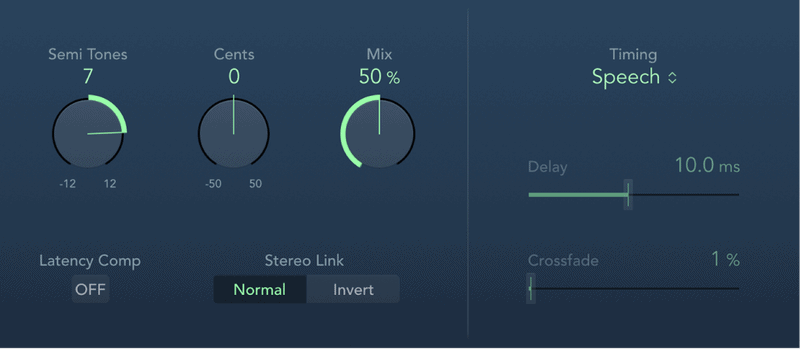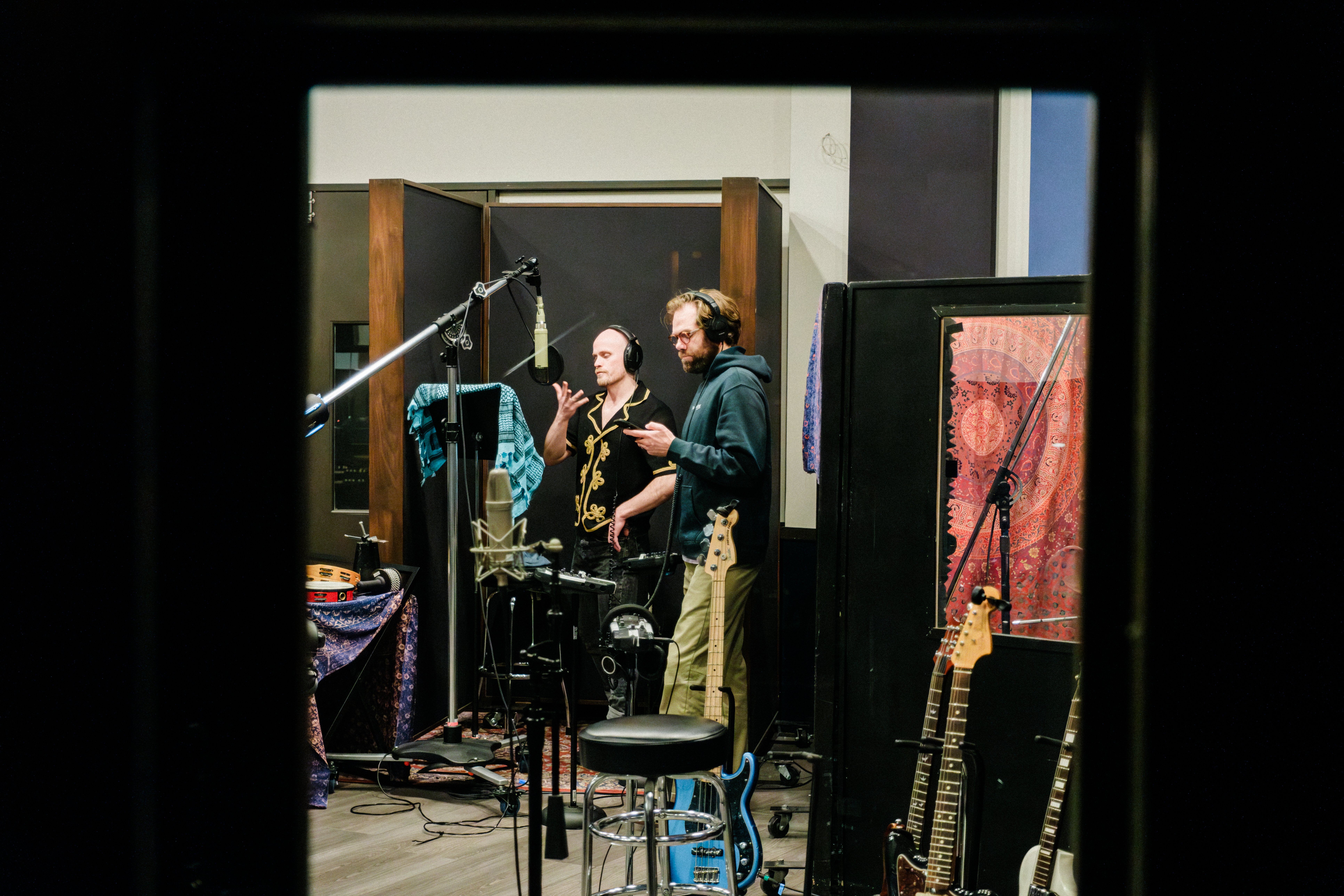A pitch shifter is not just a corrective tool, which is what it started as.
Producers are getting creative with it.
They’re using pitch shifters to make melodic elements that sometimes become the hook of the song.
So if you’re not at least experimenting with pitch shifting, you’re missing out.
Every producer needs a good pitch shifter plugin in their arsenal. Both for corrective measures and creative expression.
But if you want to learn about Pitch Shifting specifically, keep reading.
What’s a Pitch Shifter?

A pitch shifter in music is a piece of software that changes the pitch of an instrument. It does this by certain intervals called cents, semitones, and octaves.
To fully understand a pitch shifter, we have to understand what it manipulates.
It changes the waveform.
Basically squeezing it or stretching it from the sides. Making the frequency happen more or less frequently.
So the waveform will appear thinner (shorter) if it’s a higher frequency. And thicker (taller) if it’s a lower frequency.
To manipulate the pitch, you can change the octave, semitone, cent, and formant.
You can even pitch shift based on the time.
You can record a part faster or slower than the rest of the song. Then slow it down or speed it up so it sounds lower or higher respectively. (See below for examples.)
Let’s briefly cover some musical terms you need to know if you’ll be pitch shifting:
- Pitch: refers to the frequency of the note. (Higher pitch = higher note.)
- Octave: the distance between a pitch and one with twice its frequency, or twelve semitones. (It’s the same letter note but just higher or lower.)
- Semitone: also called a half step or half tone. (Moving from one note to the one directly next to it, up or down.)
- Cent: the small frequencies between semitones. (You can’t really play these, but you’ll deal with cents when you’re tuning.)
- Formant: a set of filters that reproduce characteristics of a resonant space. (For example, the human voice.)
What Does a Pitch Shifter Sound Like?
Now let me show you what pitch shifting sounds like.
Here’s an acoustic guitar I recorded for one of my songs (with some EQ):
Now here’s that same part without EQ and different pitch shifter settings…
One octave up:
One octave down:
Six semitones (half an octave) up:
Six semitones (half an octave) down:
Fifty cents (half a semitone) up:
Fifty cents (half a semitone) down:
Formant shift of seven semitones up:
Formant shift of seven semitones down:
Formant shift of eighteen semitones up:
Formant shift of eighteen semitones down:
Creative Uses of a Pitch Shifter
Think of all the settings of a pitch shifter and the number of combinations possible. You can imagine how creative some artists have gotten.
Let’s look at some examples…
Many artists will record something at a slower bpm, then speed it up to match the rest of the song but in a higher pitch.
People have also done the opposite: recorded a part faster and then slowed it down.
For example, Chuck Berry’s record label slightly sped up his song “Sweet Little Sixteen.” They wanted to make him sound just a tad bit younger.
The Beatles also used pitch shifting during the recording of “Strawberry Fields Forever.”
John Lennon wanted to use parts of takes 7 and 26. But they had recorded those takes at different tempos and in different keys.
So George Martin slowed down one of the takes so the two would match. You can hear the splice when Lennon sings “going to.” It sounds like his voice slows down.
Or there’s a more modern example like “Sorry” by Justin Bieber, produced by Skrillex.
There is a high-pitched melody that opens the song and is layered throughout. It’s the voice of the songwriter who recorded the demo, Julia Michaels, but pitch shifted.
Skrillex grabbed a little vocal run she did and pitched it down four semitones. Then pitched it up one octave (twelve semitones).
We can also look at “Seven Nation Army” by the White Stripes.
Guitarist Jack White played an electric guitar through a pitch-shifting pedal. This duplicated the sound of his guitar.
He then dropped the duplicate sound down an octave. In this way, he was able to mimic the sound of a bass guitar, as the band didn’t have a bassist.
And there’s another type of pitch shifter called a harmonizer.
A harmonizer copies the original signal and pitches it to a different note that works with the original part, depending on the key.
It basically lets you harmonize with yourself.
These are just a few examples of pitch shifting. But once you know what it sounds like, you’ll hear it happening in so many songs.
Pitch Shifter Plugins
Now let me share some pitch shifting plugins you can try out…
Celemony Melodyne 5 Essential
The main way producers use Melodyne is for auto-tuning, but at its heart, it’s a pitch shifter.
That’s what a tuning plugin is. It adjusts the pitch of something so that it’s in tune.
It’s an intuitive plugin with a drag-and-drop interface. Giving you complete control over the pitch of entire tracks or individual notes.
Antares Auto-Tune Pro
The Antares Auto-Tune plugin was the first pitch-correcting plugin on the market. And it’s still at the top of the list of best pitch shifters.
Auto-Tune Pro is the newest update, and it makes pitch-shifting simple and straightforward. Similar to Melodyne, you can drag and drop notes across pitches.
Sound On Sound says it’s worth the roughly $400.
“..The beauty of Auto-Tune Pro is that it provides the best of automatic pitch correction alongside a perfectly practical graphical editing mode within a single product,” they write.
“A worthwhile upgrade and deserving of the Pro title.”
Soundtoys Little AlterBoy
Little AlterBoy is a good fit for beginners because the interface is so simple.
It has all the basics. Plus it has pitch quantizing, a hard-tune effect, and a pitch-locked robot voice effect.
There’s even a tube saturation feature that adds edge or warmth.
Audio Damage Discord4
Audio Damage’s Discord4 is cool because it has a bunch of presets of pitched sounds. These presets also have other effects on them, like reverb and delay.
Of course, you can also manually adjust the pitch. Use the basics settings we covered in the first section.
Plus, it’s super affordable.
Final Thoughts
As you can see, a pitch shifter can come in handy when you need to correct the tuning of something. Usually a voice.
But it’s also another creative tool you can use to enhance your productions.
Hence, why you need to grab a pitch shifter plugin today.














